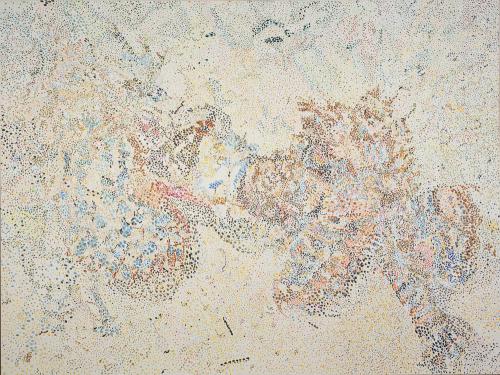Skip to main content
Camouflage Botticelli (Birth of Venus)
Artist
Alain Jacquet
(French, 1939 - 2008)
Date1963-64
MediumOil on canvas
DimensionsUnframed: 90 3/4 x 55 1/2 in. (230.51 x 140.97 cm)
Framed: 92 1/8 x 56 3/4 x 1 3/4 in. (234 x 144.15 x 4.45 cm)
Framed: 92 1/8 x 56 3/4 x 1 3/4 in. (234 x 144.15 x 4.45 cm)
Credit LineCollection of the Modern Art Museum of Fort Worth, Museum purchase, Sid W. Richardson Foundation Endowment Fund
Object number2001.9
Status
On viewSignedfront:Signed, "Camouflage Botticelli", and dated '63-64 lower left. Signed, "Camouflage Botticelli"(Birth of Venus), and dated '63 on reverse
Copyright© 2020 Alain Jacquet / Artists Rights Society (ARS), New York
Category
Label TextAlthough not directly associated with 1960s Pop art or the contemporaneous Nouveau Réalisme group active in France, Alain Jacquet shares close affinities with both movements, drawing inspiration from consumer society, popular culture, and everyday life.
Jacquet created his Camouflage series between 1962 and 1964. For Camouflage Botticelli (Birth of Venus), 1963–64, he reproduced the central figure of Sandro Botticelli’s Birth of Venus, c. 1485–86 (Uffizi, Florence), one of the most iconic paintings of the Italian Renaissance: a curvaceous, nude Venus with flowing golden hair, posed on a floating cockleshell. Jacquet, however, overlaid the figure with a gas pump emblazoned with the word and scallop-shaped logo of the Shell oil company, making a humorous, ironic connection between the goddess of classical mythology and a powerful contemporary corporation. Other paintings in the Camouflage series are based on works by Giorgio de Chirico, Roy Lichtenstein, Michelangelo, and Piet Mondrian.
In Camouflage Botticelli, Jacquet juxtaposed Venus—perhaps the most famous embodiment of female beauty and sensuality in mythology—with a hose and nozzle, parts of a gas pump that evoke male sexual anatomy. The oil corporation’s logo is directly next to the goddess’s pubis, which Venus modestly covers with her hair in Botticelli’s painting. Jacquet’s use of a well-known artwork connects him to the French artist Marcel Duchamp, and especially to Duchamp’s famous manipulated photograph of Leonardo da Vinci’s Mona Lisa, c. 1503–19 (Louvre, Paris). In 1919, Duchamp graffitied a reproduction of the Mona Lisa with facial hair, inscribing below the portrait the work’s title, L.H.O.O.Q.—letters that, when pronounced aloud in French, sound like the phrase “she has a hot ass.” Jacquet similarly endowed Botticelli’s Birth of Venus with contemporary sexual innuendo, while also pointing to the corporate world and its social impact.
Jacquet created his Camouflage series between 1962 and 1964. For Camouflage Botticelli (Birth of Venus), 1963–64, he reproduced the central figure of Sandro Botticelli’s Birth of Venus, c. 1485–86 (Uffizi, Florence), one of the most iconic paintings of the Italian Renaissance: a curvaceous, nude Venus with flowing golden hair, posed on a floating cockleshell. Jacquet, however, overlaid the figure with a gas pump emblazoned with the word and scallop-shaped logo of the Shell oil company, making a humorous, ironic connection between the goddess of classical mythology and a powerful contemporary corporation. Other paintings in the Camouflage series are based on works by Giorgio de Chirico, Roy Lichtenstein, Michelangelo, and Piet Mondrian.
In Camouflage Botticelli, Jacquet juxtaposed Venus—perhaps the most famous embodiment of female beauty and sensuality in mythology—with a hose and nozzle, parts of a gas pump that evoke male sexual anatomy. The oil corporation’s logo is directly next to the goddess’s pubis, which Venus modestly covers with her hair in Botticelli’s painting. Jacquet’s use of a well-known artwork connects him to the French artist Marcel Duchamp, and especially to Duchamp’s famous manipulated photograph of Leonardo da Vinci’s Mona Lisa, c. 1503–19 (Louvre, Paris). In 1919, Duchamp graffitied a reproduction of the Mona Lisa with facial hair, inscribing below the portrait the work’s title, L.H.O.O.Q.—letters that, when pronounced aloud in French, sound like the phrase “she has a hot ass.” Jacquet similarly endowed Botticelli’s Birth of Venus with contemporary sexual innuendo, while also pointing to the corporate world and its social impact.







